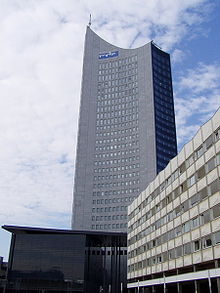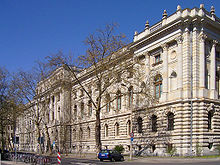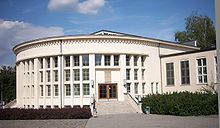历史
Founding

Former main building in front of MDR skyscraper.
The university was modelled on the University of Prague, from which the German-speaking faculty members withdrew to Leipzig after the Jan Hus crisis and the Decree of Kutná Hora. The Alma mater Lipsiensis opened in 1409, after it had been officially endorsed by Pope Alexander V in his Bull of Acknowledgment on (September 9 of that year). Its first rector was Johann von Münsterberg. One of its buildings was the Augusteum.
The University During the GDR
By the end of World War II, 60% of the university's buildings and 70% of its books had been destroyed. The university reopened on 5 February 1946, but it was affected by the uniformity imposed on social institutions in the GDR. In 1948, the freely elected student council members were disbanded and replaced by FDJ members. The chairman of the Student Council, Wolfgang Natonek, and other members were arrested and imprisoned. But the university was also nucleus of resistance. Thus began the Belter group with flyers for free elections. The head of the group, Herbert Belter, paid for his commitment to democracy with his life and was executed in 1951 in Moscow. In 1953 the University was renamed by the new rulers in "Karl-Marx-University Leipzig". In 1968, the partly damaged Augusteum including Johanneum and Albertinum and the intact St. Paul's Church were blasted to make way for redevelopment of the university. This was generated from 1973 to 1978. Dominant building of the university was the University Tower (now City-Hochhaus Leipzig) in the form of an open book.
After the Reunification
Since 1991, the University was renamed again to its original name University of Leipzig (Alma mater lipsiensis). The reconstruction of the University Library, which was heavily damaged during the war and in the GDR barely secured, was completed in 2002. In June 2006 it was agreed between the university administration and representatives of the Chinese Embassy to establish a Confucius Institute in cooperation with the Renmin University and the "National Office for Teaching Chinese as a Foreign Language". In 2008 the university was able to prevail in the "Initiative of Excellence" in Germany and received the promotion as a graduate school with the theme "BuildMoNa. Leipzig School of Natural Sciences - Building with Molecules and Nano-objects". The university was able to hold the Saxon excellence initiative, where she tries to explore common diseases more effectively with the project "Life". Also in 2008 the "Bach Archive" was declared as an associated institute. With the delivery of the University Tower to a private user, the university was forced spread some faculties over several locations in the city. Furthermore it redesigned its historical centre at the Augustusplatz. This action was highly controversial. In 2002 Behet Bonzio received the second prize in the architectural competition. A first prize was not awarded by the jury. A lobby with partial support of the provincial government called for the rebuilding of St. Paul's Church and Augusteum. This caused the resistance of the university leadership, the majority of the students and population of Leipzig. These disputes led to a scandal in early 2003, were the Rector Volker Bigl, and the pro-rectors resigned in protest against the government. This was further forced after severe tensions had built up because of the Saxon university treaty on the future funding of higher education. As a compromise they could agree on the implementation of a second competition, which only covered the Augustusplatz front of the university. On 24 March 2004, a jury chose the design by Dutch architect Erick van Egeraat, which was well received by almost all sides. He recalls the outer form of the St. Paul's Church and Augusteum, and abstracted the original building complex. The renovations began in the summer of 2005. In 2009 the University of Leipzig celebrates its 600th anniversary with over 300 scientific and cultural lectures and exhibitions. These reflects the role of the university's research and teaching from the beginning until today in Germany and Europe.
Library

University library Bibliotheca Albertina.
The University Library of Leipzig was established in 1543. It is one of the oldest German university libraries and it serves as a source of literature and information for the University of Leipzig as well as the general public in the region. Its extensive historical and special collections are nationally and internationally recognized. The library consists of the main building "Bibliotheca Albertina" and forty branches situated near their respective academic institutions. The current stock comprises 5 million volumes and about 7,700 periodicals. Collections range from important medieval and modern manuscripts to incunabula, papyri, autographs, ostraka and coins.
校园
The university's urban campus comprises several locations. The main building in the center of Leipzig went under construction in 2005; the blueprints for the new university building were drafted by Dutch architect Erick van Egeraat. The estimated total cost for the renovation project is 140 million euro. The new building is set to finish in 2009, just in time for the university's 600th anniversary celebrations.
Besides the faculties and institutions, there are several other bodies that serve the university: University Library, a university archive and administration, as well as a museum for music instruments and a university clinic. The university's Leipzig Botanical Garden was established in 1542 and it is the second oldest botanical garden in Europe. All in all, the university is spread across 38 locations in Leipzig.
The University's Musical Instrument Museum includes one of the world's three surviving pianos built by Bartolomeo Cristofori, the piano's inventor. Five other Cristofori instruments are included in the Museum's collections.
学术
Today, the university has 14 faculties. With over 29,000 students, it is Saxony's second-largest university. There are now more than 150 institutes and the university offers 190 study programs leading to Bachelor's degrees, Master's degrees, Staatsexamen, Diplom and Ph.D.s of which nearly all are tuition-free. Arguably, the Faculty of Medicine is the university's most renowned faculty.
The university offers a number of courses in English and other foreign languages and there are several programs allowing foreign students to study abroad at the university. Current exchange partner universities include the University of Arizona, University of Oklahoma, University of Houston, University of Alberta, Ohio University and University of Edinburgh among others. Traditionally contacts to universities in Eastern Europe and the Far East are strong as well, e.g. there are cooperations with leading institutions like Lomonosov University (Moscow) and Renmin University (Beijing).
There are three International Master's programs: (American Studies and Global Studies),SEPT(MBA in SME Promotion) and one Bachelor/Master's/Ph.D. program (International Physics Studies Program) taught in English. American Studies Leipzig is one of the most distinguished programs of its kind in Europe. In the last three years alone, it has been awarded three prestigious international professorships: The Fulbright-Leipzig Chair for American Studies, the DAAD Professorship for American and International Studies, and the Picador Guest Professorship for Literature. It is also the home of aspeers:emerging voices in american studies, a graduate-level peer-reviewed scholarly journal for American studies. Erasmus Mundus Global Studies on the other hand, is an interdisciplinary, research-based Master offered by a consortium of four European universities: University of Leipzig, the London School of Economics, University of Vienna, and University of Wroclaw.
The university is ranked 5th in Germany, 29th in Europe and among the best two hundred in the world by the web-based Webometrics Ranking of World Universities.
Faculties

Anatomy auditorium of the Faculty of Medicine
The original four facilities were the Faculty of Arts, Theology, Medicine, and Law. Today, the university comprises the following 14 faculties:
- Faculty of Theology
- Faculty of Law
- Faculty of History, Art and Oriental Studies
- Faculty of Philology
- Faculty of Education
- Faculty of Social Sciences and Philosophy
- Faculty of Economics and Management (including Civil Engineering)
- Faculty of Sports Science
- Faculty of Medicine (with a University Hospital)
- Faculty of Mathematics and Computer Science
- Faculty of Biosciences, Pharmacy and Psychology
- Faculty of Physics and Earth Science
- Faculty of Chemistry and Mineralogy
- Faculty of Veterinary Medicine
The following institutes are affiliated with the university:
- Herder-Institute
- East-Asian Institute of the University of Leipzig
- Institute for Religious Studies of the University of Leipzig
- Institute for Classical Archaeology of the University of Leipzig
- Institute for International Law, European Law and Foreign Public Law (InVEA)
People associated with the University of Leipzig
Main article: List of University of Leipzig people
University of Leipzig has produced many notable individuals. Some famous people affiliated with Leipzig include:
- Johann Wolfgang Goethe, German poet and polymath
- Michelle Bachelet, first female President of Chile between 2006 and 2010
- Angela Merkel, first female German Chancellor
- Felix Bloch, Swiss physicist, Nobel Prize in Physics
- Gustav Hertz, German physicist, Nobel Prize in Physics
- Friedrich Nietzsche, German philosopher
- Richard Wagner, German composer
- Wilhelm Wundt, German psychologist, founded the first formal laboratory for psychological research
- Gotthold Ephraim Lessing, German philosopher and writer
- Hans-Dietrich Genscher, German politician, Foreign Minister and Vice Chancellor
- Werner Heisenberg, German physicist, Nobel Prize in Physics
- Gottfried Wilhelm Leibniz, German polymath
- Ferdinand de Saussure, linguist, founder of structuralism
- Maximilian von Frey, physiologist, inventor of the esthesiometer
Radio
The local radio station of the University is "mephisto 97.6" and is receivable in the Leipzig area on FM 97.6 MHz and is also fed into the cable network of Leipzig at 93.6 MHz (both on a shared frequency with radio "R.SA"). It can be received monday to friday from 10 to 12am and 6 to 8pm. Therefore it can be received by over a million people in the broadcasting area.
更多
- List of universities in Germany
- Leipzig school (sociology)
- Handelshochschule Leipzig (HHL)
- Research Academy Leipzig
Links
- History of the University of Leipzig (English, German)
- History of the Library (German)
参考文献
- ^ http://www.buildmona.de
- ^ http://www.sechshundert.de/index1_e.php?JavaScript=On
- ^ http://mfm.uni-leipzig.de/_eng/dasmuseum/europ_Musical_Instruments.php?navid=16
- ^ Since the adoption of the Bachelor's degree and Master's degree only three study programs leading to Diplom have remained: Maths, Mathematical economics and Protestant Christian Theology.
- ^ SEPT, the international Program of the University of Leipzig for Small and Medium-Sized Enterprise promotion and training http://www.sept.uni-leipzig.de/
- ^ http://www.sept.uni-leipzig.de/MBA-Program.10.0.html
- ^ Homepage of the International Physics Studies Program at Leipzig
External links
- (German) (English) University of Leipzig 网址
- (German) (English) Leipziger Universitätsverlag Publishing House
- American Studies Leipzig website
 "University of Leipzig". Catholic Encyclopedia. New York: Robert Appleton Company. 1913. http://en.wikisource.org/wiki/Catholic_Encyclopedia_(1913)/University_of_Leipzig.
"University of Leipzig". Catholic Encyclopedia. New York: Robert Appleton Company. 1913. http://en.wikisource.org/wiki/Catholic_Encyclopedia_(1913)/University_of_Leipzig.



